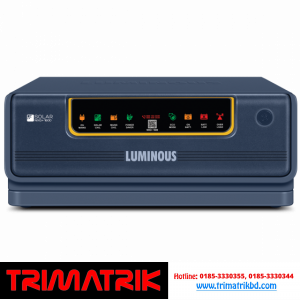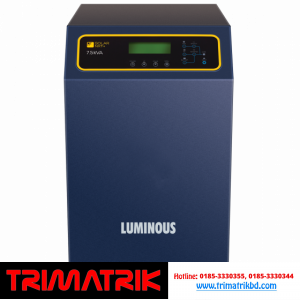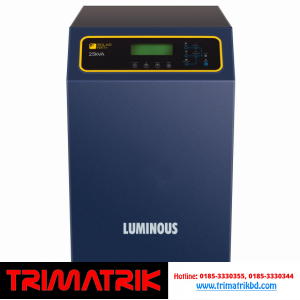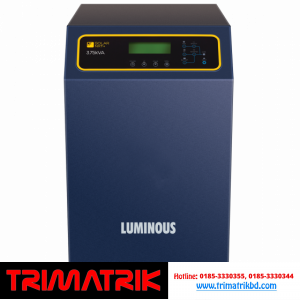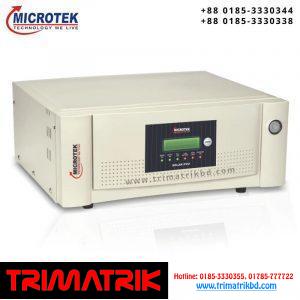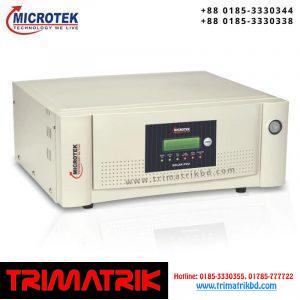Showing all 10 results
LUMINOUS SOLAR Inverter in Bangladesh
Luminous solar inverters are available in various sizes and capacities, starting from one kilowatt up to 50 kilowatts. The company offers excellent prices, with special discounts for resellers and dealers. It is available for both on-grid and off-grid solar systems. This makes Luminous solar inverter a great buy for the price conscious home or business owner. Listed below are a few of the pros and cons of Luminous solar inverters.
ESTALLBD is the Leading LUMINOUS SOLAR INVERTER Supplier in BANGLADESH.
Luminous Power Technologies is an Indian solar inverter manufacturer with an established presence in over 36 countries. The company employs over 6000 people and has seven manufacturing units and 28 sales offices in India. The company serves over 60,000 channel partners worldwide. The company has multiple international events and conferences and showcases its cutting-edge product lines at leading industry events. A quick glance at the company’s website will demonstrate why this brand is the best choice for home owners looking for an inverter for solar panels.
The Luminous NXG ranges of solar inverters are flexible and designed for a variety of solar appliances. They are pure sine-wave UPS systems, safe for sensitive electronic equipment and regular lighting loads. The company’s iSOT (intelligent system for off-grid charging) feature ensures that battery life will not be compromised, even with heavy usage. Its iSOT feature prevents overcharging and protects against short-circuiting. Luminous solar inverters are available at special prices to dealers.
The Luminous Solar Inverter uses the current produced by your solar panels to charge your battery with pure sine wave current. A square wave current is hazardous for sensitive electronic equipment. Microtek Solar Hybrid Inverters are also square wave inverters, but only the advanced models use it. In case you want to buy one for your home, you can purchase a Luminous 1500VA solar hybrid inverter with solar panels.
Luminous Solar NXG Hybrid Inverter is a powerful hybrid solar inverter that supports up to 600 watts of solar panels. It is also designed to run a high-powered 850 va load mix during power outages. This smart hybrid inverter prioritizes solar charging battery charging, and helps you save up to 3 units of electricity per day. Luminous solar inverter comes with a customer-friendly monitoring system and a detailed user manual.
Luminous NXG 1400 is the largest solar inverter on the market. It prioritizes solar energy over mains energy and is an excellent choice for an on-grid self-managed solar system. With its PWM 40 Amp/12V charge controller, this solar inverter can support up to 800 watts of solar panels. It also offers a two-year warranty and comes with all the other components of your solar power system.
As the fastest and most popular solar inverter brand in India, Luminous also has an extensive line of solar products. With over seven manufacturing facilities, it is one of the biggest and most trusted solar brands in the country. Luminous has a presence in 36 countries and employs more than 6000 people. The company has millions of satisfied customers and is an industry leader. You can read the full review on Luminous solar inverter and choose one that best suits your needs.
Luminous solar MPPT technology is the next generation of solar inverter. It is an improved version of the conventional solar inverter, with additional features. It can extract maximum power from a solar panel, and can also provide DC power to a battery bank connected to it. Luminous MPPT solar PCUs can provide enough power for various loads. Their single phase and three phase models range from forty-five watts to three hundred and thirty-five kilowatts.
The company offers an O&M service to ensure your investment lasts a long time. Their team can also assist you with system integration. Luminous Solar Inverter reviews are backed by a two-year warranty. They’re the perfect choice for the home or business owner who does not want to hire a professional to install their solar power system. The efficiency and reliability of Luminous Solar Inverter ensures your system will work reliably.
Another benefit of this solar power inverter is that it has an on-grid model. This type of solar inverter is a perfect fit for people who live in remote places. It can convert DC electricity to AC power and use it to operate appliances. It will also shut down if the grid goes down to prevent electrocution. As it is more convenient to use, it’s also cheaper. This feature makes it a great choice for homes that are remote or require remote access to power.
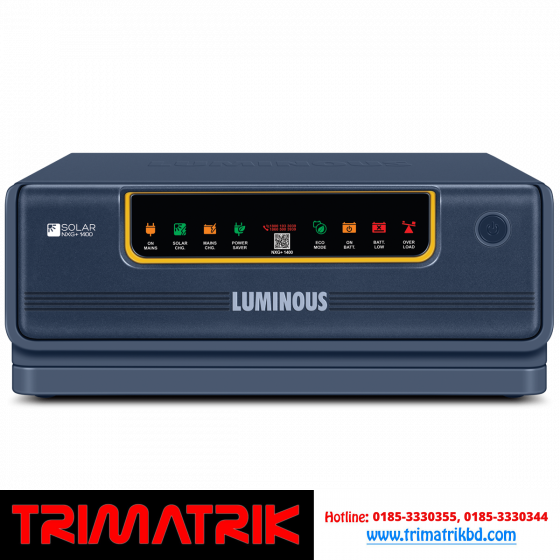
Best Luminous Solar Inverter Price in Bangladesh
| Luminous Solar Home UPS – NXG+ 1400 | 16,500 |
| Luminous Solar Home UPS – NXG+ 750 | 13,500 |
What is a Solar Inverter and How Does it Work?
Firstly, let’s look at how a solar inverter works. This electronic device converts direct current (DC) to alternating current (AC). DC electricity flows in one direction; whereas, AC alternates between the positive and negative side of the circuit. The solar inverter converts the DC to AC by switching the current back and forth until it produces an output that is consistent with the current. The latest versions of this device can also connect to a computer network, monitor the performance of your solar system and communicate with other devices. Some solar inverters can even work with your solar batteries, giving you greater independence from the grid during power outages.
When the panels and inverter are installed together, the outputs of all the panels are combined. When the sun is shining, a home PV system can produce thousands of watts of energy. However, you need to monitor your solar panels to avoid the problem. You can install an inverter that checks for the components automatically and emails the owner if there is a power outage.
Another important feature of a solar inverter is that it prevents the transmission of electricity to the external power lines. As a result, it protects line workers from injury. It also allows you to feed back surplus electricity to the grid, earning you net energy credits. You can also feed your excess electricity to the grid, depending on the size of your battery bank and the power output of your solar panels.
A solar inverter is a piece of hardware that converts DC energy to usable AC power. The device converts the energy from solar panels into alternating 120V/240V AC current. This is essential for the appliances in your home, including your AC-compatible appliances. So, what is a solar inverter? And how does it work? Let’s look at the different types.
Reactive power. This type of energy brings the voltage and current back into synchrony. It makes the electricity more convenient to use and is a byproduct of other power. Modern inverters absorb and provide reactive power. Despite its importance, it is difficult to transport and distribute this energy in large quantities. In other words, reactive power is a useful resource for distributed energy resources.
The solar inverter is a piece of equipment that converts direct current (DC) electricity into alternating current (AC). This type of electricity is necessary for your home appliances and to connect with the National Grid. Its DC counterpart is equivalent to 120 volts (in the US), while AC is equal to 240 volts. Using an inverter is necessary to make the electricity safe for your appliances.
How Does a Solar Inverter Work With Electricity?
So, how does a solar inverter work with electricity? In simple terms, it converts solar energy to electricity. But, this process is not without friction. Power conversion involves friction, a factor of 2/3 in inverters. Also, it consumes a bit of power to operate. The peak efficiency of an inverter is around two-thirds of its capacity. That is why, in order to convert solar energy into electricity, it is necessary to choose an inverter with at least 93% efficiency.
There are two types of solar inverters: string inverters and micro-inverters. String inverters are relatively easy to install and cost-effective. They come in single-phase and three-phase models. The latter are primarily used in residential and business applications. Micro-inverters, on the other hand, are limited to handling power from one or two solar panels. Whether you choose a single-phase or three-phase inverter depends on your needs and your budget.
One of the benefits of a solar inverter is that it prevents electricity from going back to external power lines. This helps protect line workers and enables you to feed back surplus electricity into the grid, or generate net energy credits. In addition, if you have a solar panel system, it can be stacked in an expensive system. The best way to get an inverter is to consult an expert before buying.
How does a solar inverter work? The solar panel is made of two semiconductor layers – a positive layer and a negative one. These two layers are connected by a junction. As light strikes the solar panel, electrons move between the positive and negative layers and produce direct current. This DC can be used directly, stored in a battery, or sent to a solar inverter. This electricity can be used in your home to power devices, such as your appliances and lighting.
There are two types of solar inverters – string and micro-string. String inverters are the more common type. They connect to multiple solar panels, and convert the DC electricity into AC electricity. Despite their popularity, string inverters can be difficult to maintain due to the possibility of single-panel malfunctions. This is why string inverters are best used for simple solar power system designs. They are inexpensive and effective, but have limited advantages. In addition, problems with a single panel can affect the entire string.
A hybrid inverter is also available. It can provide power for your home and grid, but it must be installed in conjunction with the software and changeover switches. Some companies do not include a hybrid inverter in their quotes, so you should ask a specialist for advice. Then, choose a solar panel system that works with the grid. You will be able to lower your electric bills and receive a feed-in-tariff.
How does a solar inverter work? You should check it periodically to make sure it’s functioning properly. Normally, solar panels produce thousands of watts of power on a sunny day. If you don’t regularly monitor it, your inverter will fail to work properly. Some inverters check components automatically, and some will even email you if there’s a power outage.
A solar inverter can be connected to a solar panel or a battery for storage. It converts the direct current (DC) from the solar panels into alternating current (AC). It can detect when a utility grid outage occurs and adjust the energy to the proper AC voltage. If you don’t have the solar panels, you can still use the electricity from the grid for your home appliances. However, an inverter is still more efficient than a solar panel.
What is PV in a Solar Inverter?
If you’ve been thinking of building a solar power system, you may be wondering, “What is PV in a solar inverter?” You may have heard of the PV module, but you might be unsure about the PV inverter. PV stands for photovoltaic, and it refers to the light-sensitive components in the solar panels. The PV modules are responsible for collecting and converting sunlight into energy. They are also responsible for monitoring and controlling the power grid. If the grid has problems with a PV plant, the inverter must disconnect the plant from the grid, both for safety and to protect the power grid.
In addition to providing power to a home, a solar inverter can also be used to power other appliances. In fact, most home solar inverters today include a built-in photovoltaic (PV) module that can be used to connect the system to the grid. This allows you to mix solar power with grid power, and even earn net energy credits. This is an example of a PV-powered household.
Essentially, you can string your solar panels in parallel, or in series. A parallel arrangement allows you to connect more than one panel to the same inverter, and the PV cells are connected to the negative terminals of each other. This way, if one panel is heavily shaded, the rest of the panels can still work without any loss of current. A PV inverter converts DC electricity to AC electricity in a process called “stringing”.
When you’re planning your solar PV system, you need to consider environmental conditions and local laws. Your energy grid has regulations governing solar system size and interconnection. You must follow them if you’re going to receive net-metering. In some areas, the maximum size and power output of a PV system is limited by the maximum size of the inverter. To meet your maximum and minimum energy production requirements, make sure your strings are the same length as your inverter specifications.
The PV in a solar inverter converts variable direct current to alternating current. Most appliances in your home run on alternating current, so the PV inverter needs to change that to match. Photovoltaic cells are semiconductors made of crystalline silicon with positive and negative layers connected by a junction. When solar energy hits these panels, electrons in the solar panel move from the negative layer to the positive layer. This result is alternating current, or DC.
A solar inverter can be configured to operate in grid-connected or standalone modes. Some distribution system operators allow or require specific generators to operate in island-operated mode. The stand-alone mode allows the PV system to remain active even if the grid fails. In this situation, the system can still provide electrical power to a load. It also has the ability to withstand overload situations. The stand-alone mode may be used along with a battery system for power storage.
PV inverters are an integral part of a solar power plant. They convert direct current produced by the PV modules into grid-compliant alternating current. They also monitor and control the entire plant, ensuring that the PV modules are working at maximum capacity. They also ensure compliance with various safety standards. To help you determine which one you need, here’s a look at three different types of PV inverters.
How do solar panels and solar inverters work? There are different ways to connect solar panels. Some are connected to a single PV inverter, while others have multiple solar panels connected to a string inverter. The wattage rating of the solar panels will determine the maximum number that can be connected to an inverter. If you’re planning to connect five or more solar panels, a 5,000-watt inverter can accommodate up to five kW of solar panels. By comparison, 17 solar panels may be connected to a 300-watt-per-module system.
The PV in a solar inverter converts the variable DC output of PV panels into alternating current (AC). This AC electricity can then be fed into a commercial electrical grid or a local off-grid electrical network. In addition, the PV inverter allows you to use ordinary AC-powered equipment. Moreover, solar power inverters have special functions designed for photovoltaic arrays. Some features of solar power inverters include maximum power point tracking, anti-islanding protection, and more.
The output of a PV module depends on several variables, including solar altitude. The solar PV module’s power characteristics curve is a graph whose value varies with time and temperature. The inverter must calculate and store the power generated by a PV module at a certain point on the curve. This process is known as maximum power point tracking and is based on standardized test conditions. It is essential for the energy output of a PV plant.
Solar Inverter Buying Guide in Bangladesh
Finding a good Solar Inverter buying guide is extremely important when looking for one. You must first determine the area of your house and all the appliances that you would use with it. Once you know these facts, you can begin to compare solar inverters and choose one that will meet your needs. In order to do this, browse the Internet and read customer reviews. The more reviews the better, but don’t let a low number of reviews put you off.
Once you’ve determined the number of appliances that you use daily, you can now determine the power rating of each unit. The power rating tells you how much it can handle, how many loads it can support, and how many devices it can simultaneously support. For best results, choose a solar inverter with a power rating that is at least 10% higher than the rated amount. Make sure to read the installation manual as well.
You should also determine the lifespan of your solar inverter. A high-quality model should last at least 10 years, although if you’re lucky, it could last up to 15 years. Lower-priced models will likely last less than 5 years. You may also want to choose a monitoring system for your inverter. These systems are not only important for monitoring your solar panels, but also help you to identify any performance issues with your solar system. A good solar inverter will last many years, so you should choose one that will do its job and give you peace of mind.
Before you purchase a solar inverter, make sure to consider the size and wattage of your appliances. Then, you can figure out how much power you need. For example, a basic solar inverter will provide you with voltage outputs of 120 to 240. For a basic home application, this should be more than enough. For large appliances, however, you should look for higher capacity solar panels.
An LCD display is also essential. These displays display the input and output voltages, as well as a safety protocol that prevents short-circuits and overheating. Lastly, you should look for a solar inverter that has sensory overload protection to prevent sensory overload and maximize solar energy output. In addition to being more efficient, a solar inverter can reduce energy bills and help you earn net energy credits.
You should start by using a search engine to find a reputable online store that offers solar inverters. A few national websites sell these units, but you should avoid buying one from a website that does not have a high rating. Reviews will inform you of the real user experience, and will help you choose the solar inverter that suits your needs. Once you have narrowed down your search, you can then visit a website that seems most appealing. Explore their wide selection of inverters, and make a decision based on what you have read.
You will also want to find a model with a fan-forced cooling system. These will help keep the unit cool, which increases power output and lowers the risk of overheating. They can be configured to provide the best user experience and help reduce the risk of energy loss. An inverter with WiFi monitoring capabilities is the most convenient for most users. The inverter that works best with battery systems is lightweight and ergonomic.
An inverter must be able to charge its battery sufficiently before it can be used. This is particularly important for complex solar systems, and the best solution for this is a DC power optimizer. These systems also help monitor the performance of the solar system and aren’t likely to break the bank. Look for the SolarEdge brand and look for reviews from satisfied users. This will help you make the right decision when choosing a solar power system.
Inverters are crucial components of solar power systems, and are vital to the success of the entire process. Without an inverter, you won’t be able to use the energy from your solar panels to run your appliances. They also regulate the voltage and create a separate powerhouse for your appliances. It is recommended that you buy a sine wave inverter for your home appliances, because most appliances will work safely on this type of electricity.


